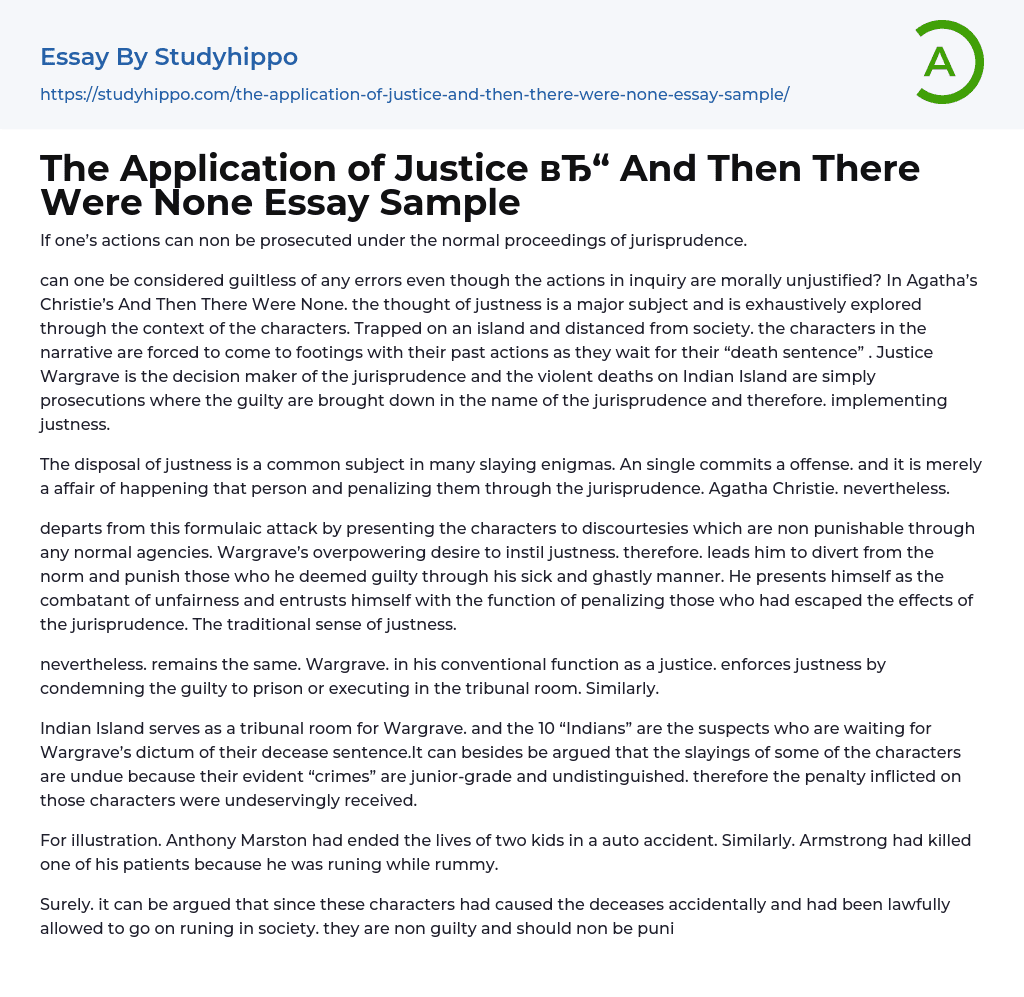

The Application of Justice And Then There Were None Essay Sample
Standard legal procedures cannot be used to hold a person accountable for their behavior.
Is it possible to escape blame for wrongdoing even if the actions themselves are immoral? Agatha Christie's And Then There Were None delves extensively into the concept of justice, particularly through the experiences of its characters. Stranded on an isolated island, the characters must confront their past deeds and await their inevitable punishment. In this scenario, Justice Wargrave serves as both judge and executioner, meting out justice by eliminating the guilty in the name of the law.
The theme of justice is frequently found in murder mysteries where the perpetrator of a crime is identified and punished according to the law. Agatha Christie is known for exploring this topic.
In departing from the usual method of attack, this text showcases characters who commit discourteous acts that cannot be puni
...shed through conventional means. Wargrave's strong desire for justice drives him to deviate from typical procedures and use his disturbing and gruesome tactics to punish those he deems guilty. He positions himself as the opponent of injustice and takes it upon himself to discipline those who have evaded legal consequences. This challenges traditional notions of justice.
Despite this, Wargrave still fulfills his traditional role as a justice by imposing justice through imprisonment or execution in the courtroom against those who are guilty. This remains unchanged in his duties.
The 10 "Indians" on Indian Island are awaiting Wargrave's ruling on their death sentence in the tribunal room. Some may argue that the murders of certain characters are unjust as their supposed crimes were minor and insignificant, resulting in their undeserved punishment.
As an example, Anthony Marston caused the deaths of
two children in a car accident, while Armstrong ended the life of a patient due to being under the influence.
It can be argued that although these characters caused fatalities unintentionally and were permitted by law to continue living in society, they are still culpable. Their guilt is further established by their conscious awareness of their actions.
Guilt arises from making a mistake or engaging in criminal behavior; if these things did not occur, guilt would not exist. An example of this is Vera Claythorne, who recognizes her fault and chooses to hang herself as a result.
The text highlights the powerful realization that one's own guilty conscience can manifest itself as a symbol of justice. Dr. Armstrong, on the contrary, frequently has dreams that reflect the time he killed one of his patients. Therefore, the characters are often reminded of their crimes by their inner conscience.
Furthermore, it also functions as a means of promoting justice by occupying the thoughts of the characters with a sense of guilt and subjecting them to torture until their demise. Additionally, Wargrave deemed the severity of justice based on the gravity of the wrongdoing. Individuals who were less culpable, such as Antony Marston, were given a swift punishment.
There was a painless death, sparing individuals the burden of enduring the severe mental consequences of their guilt and the impending approach of death, particularly those undoubtedly guilty.
Despite everything, the characters had to bear the psychological burden of guilt until they faced their judgment day. This was most evident in the case of Vera Claythorne, who chose to end her life after struggling with the trauma of her experience on the island and
her overwhelming sense of guilt.
Similarly, Wargrave, who aligns himself with the executioner of justice, does not exempt himself from punishment. As his victims were each murdered, Wargrave ultimately takes his own life.
In her novel, Agatha Christie strays from the typical detective crime fiction approach by incorporating the idea that even those who are guilty can still face justice. This is demonstrated through Wargrave's eventual fate, which he has no control over.
Traditionally, justice is administered by incarcerating offenders, but in And Then There Were None, justice is represented by death.
The implementation of capital punishment, although severe, is a matter of justice that requires impartial treatment for everyone and is not considered an inhumane means of penalizing offenders.
The idea that the individuals in Agatha Christie's "And Then There Were None" should suffer consequences for their role in causing fatalities appears reasonable. The original source is CHRISTIE, Agatha; "And Then There Were None"; May 1995; Berkley Pub Group; Reissue edition (May 1995); comprising of 208 pages.
- Animal Cruelty essays
- Law Enforcement essays
- Juvenile Justice System essays
- Surveillance essays
- Forensic Science essays
- Crime Prevention essays
- Criminal Justice essays
- Criminology essays
- Drug Trafficking essays
- Juvenile Delinquency essays
- Organized Crime essays
- Penology essays
- Prison essays
- Property Crime essays
- Punishment essays
- Serial Killer essays
- Sexual Offence essays
- Victim essays
- Crime scene essays
- Punishments essays
- Charles Manson essays
- Juvenile Crime essays
- Piracy essays
- Stealing essays
- Gang essays
- Hate Crime essays
- Homicide essays
- Damages essays
- Murder essays
- Robbery essays
- Ted Bundy essays
- Prostitution essays
- Violent crime essays
- Rape essays
- Identity Theft essays
- Sexual Harassment essays
- Distracted Driving essays
- Drunk Driving essays
- Detention essays
- Sexual Assault essays
- Sexual Assault on College Campuses essays
- Cyber Crime essays
- White Collar Crime essays
- Fur essays
- Federal Bureau Of Investigation essays
- Fire Department essays
- Criminal Justice System essays
- Commitment essays
- Mass Incarceration essays
- Kill essays



